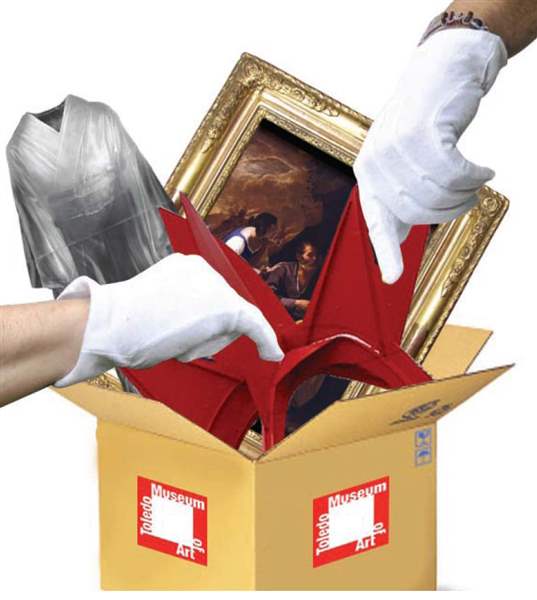
Moving priceless works is an art
8/7/2011
BLADE ILLUSTRATION

Frank Stella said he thought 'Moutonville IV' would make a great building design.
Packing up the truck to send Frank Stella’s oversized paintings on the road was like piecing together an awkward polygon puzzle.
The giant paintings recently on display at the Toledo Museum of Art, some of which are 10 to 13 feet tall, 10 feet wide, and 4 inches deep, had jutting edges and awkward zig-zags that made organized packing almost impossible. Paintings were flipped this way and that, with some resting on an "A frame," or ramp-shaped cradle, to support those too tall to sit up straight.
Shipping the works that were part of the Irregular Polygons exhibit by the renowned artist illustrates the difficult, detailed, and time-consuming process necessary to bring in — and ship out — many of the museum’s major attractions.
Just to get the paintings in the truck, Andrea Mall, associate registrar at the museum, had to construct a diagram of the gallery where the paintings would hang. She closed off the museum’s loading dock for a week to prepare for the works’ arrival, triple checking measurements and angles to determine if the paintings would even make it into the building.
And two weeks ago, when the paintings left, she had to do it all again — without anyone but essential crew members knowing her plans.
"Most people don’t know when things are happening," Ms. Mall said. "Even internally, most of the staff don’t know what’s happening. Our office always knows because we have to make the arrangements... but other than that we don’t really talk about the specifics until something’s already [arrived or left]."
This is the behind-the-scenes process that happens year round for every work of art that is loaned to or borrowed from the museum. Priceless works leave the safety of the museum walls to brave the elements, thieves (a valuable Goya painting owned by the museum was stolen in transit in 2006 but quickly recovered), train rides, plane rides, and more, typically with the assistance of only one museum courier.
"A courier is basically an art nanny," Ms. Mall said. "When we loan a work of art... we will send one of our staff members with it to travel with the crate and the work of art just to make sure everything is going smoothly."

They watch the work’s every move.
First, it is packaged in a custom-made crate. The crates are filled with foam and often double layered "to keep the art as far away from outside elements as possible," said Pat Whitesides, registrar at the Toledo Museum of Art.
The more packaging surrounding the art, the harder it will be for outside temperatures, precipitation, or accidental scrapes and bumps to affect it. This is especially important since loading the packaged works frequently requires fork lifts and cranes when man-power isn’t enough, and art can spend a lot of time outdoors when in transit.
The preferred method of transportation is by truck or van. The vehicles are specially designed to be taller to fit large works (or smaller for a single, small painting), are temperature and sometimes humidity controlled, and have precise scheduling to speed up the shipping process. For international shipping, the Toledo Museum of Art prefers to ship by plane.
But even art shipped by aircraft isn’t an easy alternative. Couriers accompanying a work to be flown overseas need to observe as much of the loading and packaging as possible. Frequently couriers will watch the art crates be "palettized," or strapped to a metal palette with plastic, but won’t see the actual work loaded onto the flight.
Ms. Mall said couriers then have to check through a third party, or someone who works at the airport, to be sure the work was actually loaded onto the plane and that it wasn’t placed next to a piece of cargo that could damage the work.
"I’ve traveled with a horse from Italy back into the States," Ms. Whitesides said. "It had its handler with it, so it was down in the cargo area with our painting, but was separated by two other pieces of cargo. We’ve also had someone go to Japan with our El Greco painting, and that was in the company of some cattle. So art sometimes has strange travel mates."
When the artwork arrives at its destination, couriers prefer it be given 24 hours to acclimate to the temperature of its new home.
"We don’t want to shock the paintings," Ms. Mall said.
Ms. Mall has a full plate ahead of her with the shipments coming to the Toledo Museum of Art throughout the next year.
"It’s really the gamut of challenges," said Kelly Garrow, the museum’s director of communications. "There’s a contemporary show that’s huge, a glass show that’s fragile, and then there’s the Manet show that’s completely international."
Before temperature-controlled vans and trucks, giant tractors were the solution for cross-country shipping, Ms. Whitesides said. When not using tractors, the art was shipped by rail and sent overseas by sea freight.
Ms. Mall said the museum has telegrams on record indicating cargo ships delivering works and their subsequent transportation by rail. It also has a list from World War II indicating specific paintings to save and how to move them in case the museum were to be damaged or invaded.
Although shipping art — particularly large or fragile works — is a difficult process full of meticulous calculations, precise details, and secret plans, Ms. Whitesides said it’s not overly stressful.
"For hundreds of years things moved by ox cart, without benefit from contemporary packing or transport methods," Ms. Whitesides said. "I’m not recommending we go back to ox carts, but on the one side, art is fragile... but we have a lot of it left, so there’s a sturdiness there too if you take the right precautions."
Contact Ashley Sepanski at: asepanski@theblade.com or 419-724-6082.